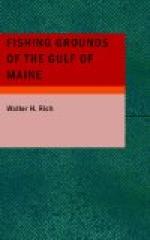St. Georges Bank, more generally known as Georges Bank. [15] This is by far the largest and most important fishing ground near the coast of the United States and is second to none in the western Atlantic except the Grand Bank of Newfoundland. It lies eastward of Cape Cod and Nantucket Shoals and is apparently an extension of the latter, since the water is no deeper between the southern part of the shoals and the western part of the bank than in many places upon it. Its southern limit, as shown on the chart, is 40 deg. 40’ north latitude, though the 50-fathom line extends 7 miles farther south. The southern limit, therefore, may be considered to be about 40 deg. 30’ and the northern as 42 deg. 08’ north latitude. The eastern part is in about 66 deg. and the western in about 69 deg. west longitude. The greatest length from the northeastern to the southwestern extremity is about 150 miles; the greatest width, N. and S., about 98 miles, according to the charts of the Coast Survey.
Depths range from 2 to 50 fathoms. On the western part, between the parallels of 41 deg. 10’ and 41 deg. 53’ north latitude and the meridians of 87 deg. 20’ and 68 deg. 37’ west longitude are a number of shoals, known as the East Shoal, North Shoal, Southwest Shoal. Cultivator, etc. The Southwest Shoal is the largest, being 15 miles long SSW and NNE., with an average width of 2 1/2 miles. The position of the center of this shoal is 41 deg. 39’ north latitude and 67 deg. 48’ west longitude. There are from 2 to 15 fathoms of water on the shoals and between them are depths of from 12 to 30 fathoms. The tide sweeps over these with great force, causing strong rips, and during rough weather the sea breaks heavily on them, rendering approach to their vicinity extremely hazardous.
Over most of the bank the bottom is sand, although patches of rough ground (gravel, pebbles, and rocks) of greater or less extent are found in some localities. Its position between the Bay of Fundy and the Gulf Stream cause the tide to run swifter than on other banks and to swirl around instead of passing directly over, back and forth. The writer has seen two men have difficulty in holding an empty dory against the current.
The Report on the Fishery Industry of the United States, in 1887, says that the first attempt at fishing here (of which there is any record) was made in 1821 by three Gloucester vessels. The cod and halibut industry, according to the same authority, began in 1830, although not fully established as a permanent industry until 1835.
The area of the whole bank is approximately 8,050 square miles, all of which, except for the shoals, is available in summer for the taking of cod, haddock, cusk, halibut, and hake, with a considerable amount of mackereling and swordfishing, as well as the taking of other species.




